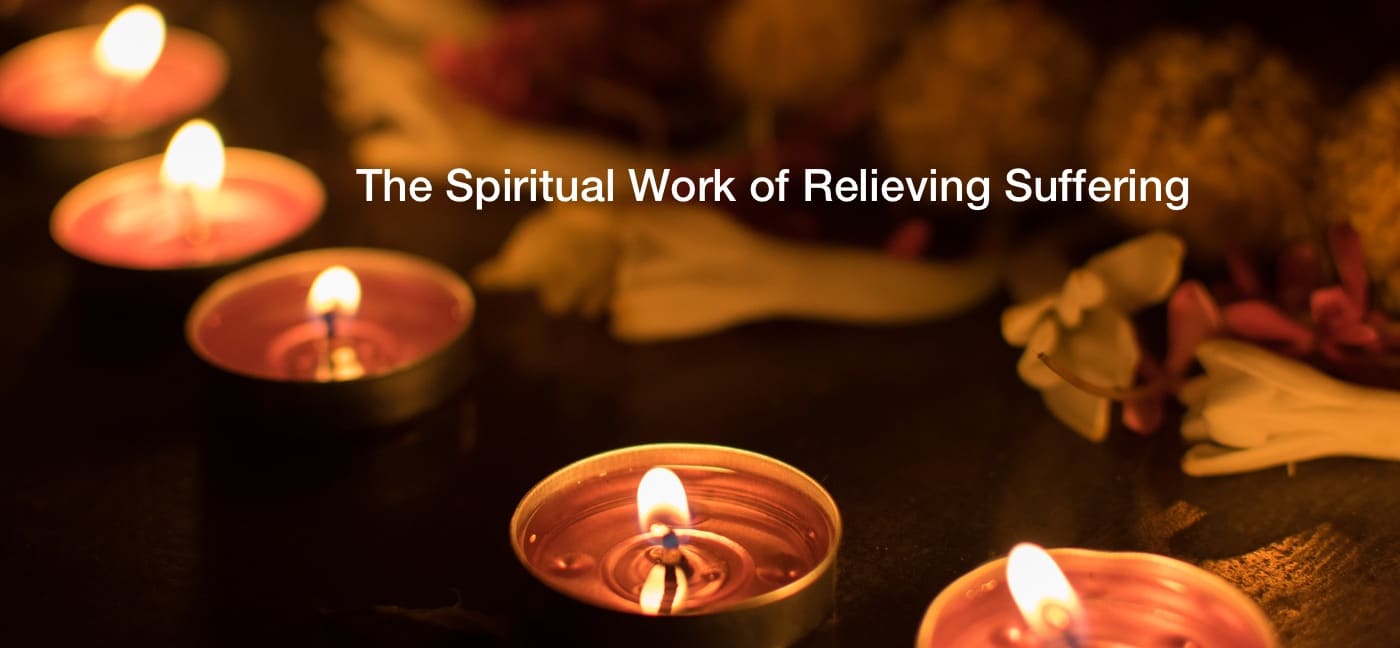The Spiritual Work of Relieving Suffering

Doctors witness pain. Every day. It’s what we do. And one way or another we have to make sense of it. The sheer intensity and scale of it. Here is where my faith comes in.
This year I started work as a newly minted physician in one of the most under-served communities of Pittsburgh. On my way to work, I often invoke this prayer:
Om Bhur Bhuvaḥ Swaḥ
Tat-savitur Vareñyaṃ
Bhargo Devasya Dhīmahi
Dhiyo Yonaḥ Prachodayāt
This is the Gayatri mantra, one of the most sacred prayers in Hinduism. In times of great need, but also in moments of reflection, stillness, and silence, these words lift me, especially during the past year. Here is the basic meaning: We meditate on that most adored Supreme Lord, the creator, whose effulgence (divine light) illumines all realms (physical, mental and spiritual). May this divine light illumine our intellect.
In medical school I learned that what we witness as healers can be devastating and painful, joyful and profound. We truly see humanity in its best and worst moments — from cradling a newborn baby, to treating painful chronic disease, to letting go at the moment of death. I learned that the medical system can act in deep selfishness, with little compassion for its practitioners or patients, but also that deeply devoted healers can provide impetus for change.
The work can so easily become a reflection of ourselves — our experiences, aspirations, personalities, loves, and fears.
A patient’s suffering somehow feels personal. The inability to “cure” someone of their addiction becomes infuriating. The sadness over poverty and its resulting consequences — poor mental health, poor housing, economic disempowerment, poor representation, limited education — becomes a source of dismay and despair. There are limits to what medicine can accomplish. When our training fails us, it is easy to feel lost. Science cannot explain the mystical connection between body and spirit that makes life so messy.
In this process, my faith is a constant call to growth and awareness. It continually reminds me of the forces beyond myself that pull me and everything around me. And my inexorable connection to those forces, which Hindus often refer to as Brahman, God, or Self, drives my actions.
A few weeks into residency, I pulled over on the side of the road while returning from the hospital, my eyes thick with tears. I was mentally and physically exhausted, having worked over 80 hours for many weeks and processed into my own being what felt like endless suffering on the part of the patients and community. Anguished and overwhelmed, I sobbed and sobbed, asking how I had arrived at this point of such agony. Instinctively, I started singing the Gayatri Mantra, and I recalled Gita.
The Bhagavad Gita is one of the most sacred texts in Hinduism — it represents a dialogue between Prince Arjuna, who is forced to fight his own cousins in the epic battle known as the Mahabharata, and the deity Krishna. Arjuna, torn between his duty as a warrior and his delusions about killing his own cousins, sinks into existential paralysis on the battlefield. Krishna reveals in this dialogue that the purpose of our lives is to realize God by making all work an offering to God and become devoted to something larger than the self. In doing so, one becomes beautiful and pure, like the lotus floating above muddy waters.
At one moment, Krishna reveals himself to Arjuna in his most supreme form and shares the ultimate knowledge that all paths lead to Brahman. Everything else is maya, an illusion. As he says: “There is nothing that exists separate from me, Arjuna. The entire Universe is suspended from me as my necklace of jewels … I am the taste of pure water and the radiance of the sun and moon. I am the sacred word and the sound heard in air, and the courage of human beings. I am the sweet fragrance in the earth and the radiance of fire; I am the life in every creature and the striving of the spiritual aspirant.”
A profound unity holds what we call this universe together.
To understand this reality, Gita recommends training the mind and body to adequately perform our duties toward the people around us — family, friends, patients, colleagues, and even ourselves. Through selfless action, meditation, and devotion to God, we come to know our real nature as one with the immortal Being that is Brahman. “Those who know the truth of the world know the illusion of the ego,” states Krishna as he reminds Arjuna of permanent reality beyond the impermanent body, mind, and intellect.
As a physician who frequently confronts situations beyond my control, these words and ideas always provide deep solace — whatever happens in life unfolds according to the merciful and mysterious laws of karma, the outcomes of cause and effect over lifetimes that we comprehend only by faith. So, when I hear a baby wail, a mother grieve, or a lonely old person in debilitating pain, I know that it is my duty to care for those in my spheres of influence through work, meditation, and prayer. It isn’t always comfortable or glamorous — like a chariot pulled by many horses, I am often stretched in many directions. But by performing my duties, I’ve found joy in being present to the process of growing and learning.
Esha Khurana attended the Perelman School of Medicine at the University of Pennsylvania and is currently a physician in Pittsburgh. Throughout her formative years, she took frequent trips with her family to visit relatives in India.
Editor’s note: This essay is part of a series that answers the question: “How does your faith help you deal with suffering and adversity?” Perspectives from a variety of religions allow us to better endure the spiritual challenges we all face as human beings.



